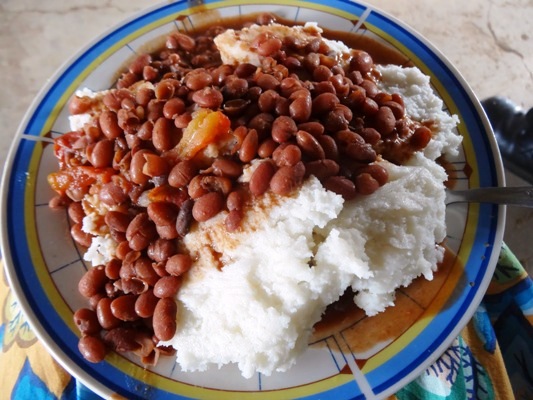human traffickingFeatures
Rise in unbalanced meals poses health risks

Posho and beans has become the food Ugandans eat most
We are consuming an increasing amount of starch, sugar and fats and less of the essential foods I.e vegetables and fruits as nutritionists advise. And for this, we are paying a heavy price in terms of increased expenditure on treating diseases that arise from unbalanced meals, loss of life, rather prematurely and misallocation of public resources towards the health sector instead of channelling the funds to development purposes.
According to Prof. Archileo Kaaya, the Head of the Department of Food Science and Technology, consumption of maize (mostly as flour) has increased to about 25% of our daily meals, a dramatic change from the past.
Findings by this paper indicate that the growing consumption of sugars and starchy foods is a global threat arising mostly from policies that promote and subsidize production of cereals, sugar and fats.
A team of researchers compared global agricultural production with nutritionists’ consumption recommendations and found a drastic mismatch.
“We simply can’t all adopt a healthy diet under the current global agriculture system,” said study co-author Prof. Evan Fraser, holder of the Canada Research Chair in Global Food Security and director of University of Guelph Arrell Food Institute. “Results show that the global system currently overproduces grains, fats and sugars, while production of fruits and vegetables and, to a smaller degree, protein is not sufficient to meet the nutritional needs of the current population.”
Published in the journal PLOS ONE, the study calculated the number of servings per person on the planet for each food group based on Harvard University’s “Healthy Eating Plate” guide, which recommends that half of our diet consist of fruits and vegetables; 25 per cent, whole grains; and 25 per cent, protein, fat and dairy.
Researchers calculated how much land is currently used for farming and how much would be needed if everyone followed the nutritional recommendations. They then projected those numbers for 2050, when the global population is expected to reach 9.8 billion.
They found that we now produce 12 servings of grains per person instead of the recommended eight; five servings of fruits and vegetables instead of 15; three servings of oil and fat instead of one; three servings of protein instead of five; and four servings of sugar instead of none.
“What we are producing at a global level is not what we should be producing according to nutritionists,” said Fraser, whose co-authors include Krishna KC, research scientist in the Department of Geography, Environment and Geomatics; Profs. Nigel Raine and Madhur Anand, School of Environmental Sciences; and Prof. Malcolm Campbell, Department of Molecular and Cellular Biology.
Because carbohydrates are relatively easy to produce and can feed many people, developing countries focus on growing grains, said KC, lead author of the study.
He said developed countries have subsidized grain and corn production for decades in order to become self-sufficient and to establish global leadership in their production. These countries have also spent far more money on research and innovation for these crops than for fruits and vegetables.
“Also fat, sugar and salt are tasty and are what we humans crave, so we have a real hunger for these foods,” said KC. “All of these factors combined have resulted in a world system that is really overproducing these types of foods.”
The study found that adopting a more nutritious diet is not only good for us but also good for the planet.
“If we do switch to nutritious diets, we would see a drop in the amount of land required to feed our growing population,” said KC.
The researchers also found that shifting production to match nutritional dietary guidelines would require 50 million fewer hectares of arable land, because fruits and vegetables take less land to grow than grain, sugar and fat.
But to achieve this decrease, consumers would need to eat less meat, and the agri-food sector would have to produce more plant proteins.
“Major players in the protein industry are investing in alternative protein options such as plant-based proteins, and consumers are taking advantage of the recent increase in alternative protein options hitting the market,” said Fraser.
Without any change, feeding 9.8 billion people will require 12 million more hectares of arable land and at least one billion more hectares of pasture land, said Fraser.
“Feeding the next generation is one of the most pressing challenges facing the 21st century. For a growing population, our calculations suggest that the only way to eat a nutritionally balanced diet, save land and reduce greenhouse gas emission is to consume and produce more fruits and vegetables as well as transition to diets higher in plant-based protein.”
Comments


























